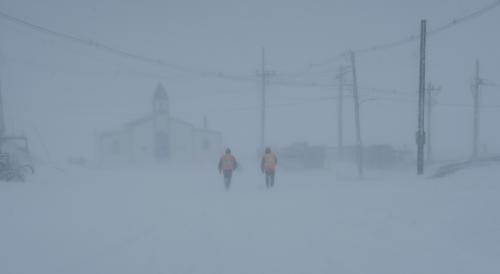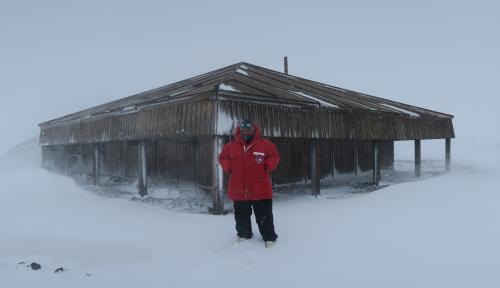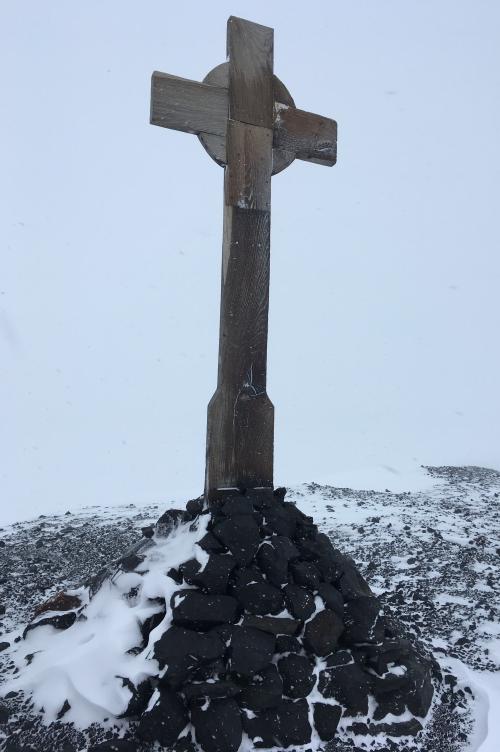It Never Rains in Southern California (But Man Can it Snow in Antarctica!)
First of all, I am going to come out up front and apologize. As you have probably figured out by reading my previous journal entries (and if you haven’t, now is a great time to get started), I like to end my journal entries with a preview of coming attractions, giving you an idea as to what to expect in the next posting. Well, for my originally planned journal, I will delve into the science involved in Automatic Weather Station (AWS) units and I wanted to make sure that I “dotted my I’s and crossed my T’s” before publishing it. So, while I am putting my final touches on that post, I have decided to write about an interesting experience that I had today, with not much science but a whole lot of history!
Today began as what has become a routine occurrence. We sign up for a flight to travel to an AWS site and then find out the day of the scheduled flight that it is cancelled. The weather has prevented us from reaching many of our planned AWS sites (I feel fortunate now that we have made it to at least one AWS). That said, these inconveniences were not totally unexpected. The unpredictability of the weather in Antarctica plays a large role as to whether if, when, and for how long scientists can conduct their work in the field.
With another day cooped up in a warm office watching large snowflakes fall to the ground and gusts of wind currents circulating the flakes into unique circular patterns, Carol came up the with perfect idea – “Do you want to go for a hike to Discovery Hut?” Now, I have heard a lot about Discovery Hut in making my preparations for my trip to Antarctica and had an idea as to its historical significance but really was not sure how long the hike would be. I was told it would be a short hike, which under normal weather conditions, would be exhilarating. The problem was that it was cold, windy, and snowing. In fact, I had heard that the snow accumulation from the storm over the past several days has been the largest around McMurdo for a long time. Not sure if and when I might have the chance to visit Discovery Hut during my dwindling length of stay in Antarctica, I said sure, so I proceeded to put on my Extreme Cold Weather gear and waited for my colleagues to get dressed as well before we all proceeded out the door and into the cold.
 Beginning our hike to Discovery Hut.
Beginning our hike to Discovery Hut.
We began our trek through the other side of our dorms and up a hill for about 15 minutes. The biting wind, walking or sloshing through an accumulated 9.5 inches plus of snow with some areas covering patches of ice, and low visibility tended to make this hike challenging, but we were able to make it to Discovery Hut, stopping along the way for some photos.
 Photo on our way to Discovery Hut.
Photo on our way to Discovery Hut.
 Another photo on our way to Discovery Hut.
Another photo on our way to Discovery Hut.
 A third and final (I promise) photo on our way to Discovery Hut.
A third and final (I promise) photo on our way to Discovery Hut.
We finally made it to Discovery Hut, and at first glance, it looked like nothing more than an old wooden shed. I then did the touristy thing by taking pictures of the structure, the monument dedication, and of course the scenic views from atop of the hill. But as I looked at the structure more closely, it gave me time to reflect on the historical aspect of this structure and its true value to the scientific community.
 A photo of Discovery Hut as we approached.
A photo of Discovery Hut as we approached.
 Me standing in front of Discovery Hut.
Me standing in front of Discovery Hut.
Discovery Hut was constructed by one of the first true pioneers in Antarctica exploration, Robert F. Scott in 1902 as part of the Discovery Expedition which took place from 1901 – 1904. Scott was an officer of the British Navy who led two expeditions in Antarctica on a quest to be the first to reach the South Pole. The hut was erected during his first expedition, Discovery Expedition (1901 – 1904). It was the second expedition, Terra Nova Expedition, that would claim the life of Scott on March 29, 1912. In an ironic twist of fate, Scott would be the second to reach the South Pole, trailing Roald Amundsen by four weeks. The history of Antarctica exploration and discovery is an interesting topic of its own, and I would encourage the reader to learn more about Scott and his expeditions. As a memorial to Scott and his crew, a cross originally erected in 1913 now stands on Observation Hill.
 Observation Hill cross.
Observation Hill cross.
 Three of us standing in front of Observation Hill cross.
Three of us standing in front of Observation Hill cross.
 A memorial plaque at Observation Hill cross.
A memorial plaque at Observation Hill cross.
 A final look at Discovery Hut before heading home.
A final look at Discovery Hut before heading home.
Thinking about the Discovery Hut, it was within this structure that Scott and his crew conducted his scientific investigations and analyses of observations around them. What amazes me is not so much what they did, but rather what they did based on the equipment, materials and resources that they had available to them.
- There were no detailed maps, satellite images or GPS to help them navigate the terrain.
- There were no accurate instruments to measure or predict the ever changing and unforgiving weather.
- There were no cell phones or radios to assist them in communication between crew members or the outside world.
- There were no computers or internet to help them record, analyze or share their results with colleagues.
- There was no electricity to power any scientific equipment or maintain warm temperatures within the hut.
- There was little knowledge of the effects of extreme cold on the human body such as hypothermia or frostbite and any effective means of treatment.
- There were no cold weather accessories such as hand/toe warmers, Big Red parkas, or “Bunny boots” to provide protection from the cold and traction against the slippery slopes.
Yet given all of these severe hardships and obstacles, Scott and his crew were able to do so much with so little, paving the way for the first class, wide-ranging scientific initiatives being conducted in present day Antarctica. I often wonder how far scientists would get conducting their research today given the equipment, materials and resources available in the time of Scott.
As we wrapped up our hike, we headed to Crary Lab to take off our ECW gear and then head to the galley for a nice, warm lunch. As we sat down to eat, I was reminded of a recent article in the New York Times that I came across prior to my trip to Antarctica that brought an interesting viewpoint to what I had just observed. I would tell you what the article was about and give you a synopsis but I think the title of the article says it all – “Fruitcake from Robert Scott Expedition is “Almost” Edible at 106 Years Old.” (Joseph, Y. New York Times; August 13, 2017).
Coming Up Next: This past week, I got to do something that took me back. Way back. More like 32-years back.


Comments
Add new comment